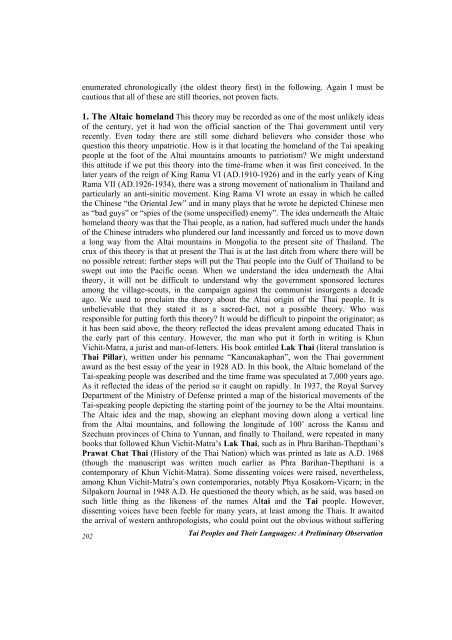Tai Peoples and Theirs Languages: A Preliminary ... - Khamkoo
Tai Peoples and Theirs Languages: A Preliminary ... - Khamkoo
Tai Peoples and Theirs Languages: A Preliminary ... - Khamkoo
You also want an ePaper? Increase the reach of your titles
YUMPU automatically turns print PDFs into web optimized ePapers that Google loves.
enumerated chronologically (the oldest theory first) in the following. Again I must be<br />
cautious that all of these are still theories, not proven facts.<br />
1. The Altaic homel<strong>and</strong> This theory may be recorded as one of the most unlikely ideas<br />
of the century, yet it had won the official sanction of the Thai government until very<br />
recently. Even today there are still some diehard believers who consider those who<br />
question this theory unpatriotic. How is it that locating the homel<strong>and</strong> of the <strong>Tai</strong> speaking<br />
people at the foot of the Altai mountains amounts to patriotism? We might underst<strong>and</strong><br />
this attitude if we put this theory into the time-frame when it was first conceived. In the<br />
later years of the reign of King Rama VI (AD.1910-1926) <strong>and</strong> in the early years of King<br />
Rama VII (AD.1926-1934), there was a strong movement of nationalism in Thail<strong>and</strong> <strong>and</strong><br />
particularly an anti-sinitic movement. King Rama VI wrote an essay in which he called<br />
the Chinese “the Oriental Jew” <strong>and</strong> in many plays that he wrote he depicted Chinese men<br />
as “bad guys” or “spies of the (some unspecified) enemy”. The idea underneath the Altaic<br />
homel<strong>and</strong> theory was that the Thai people, as a nation, had suffered much under the h<strong>and</strong>s<br />
of the Chinese intruders who plundered our l<strong>and</strong> incessantly <strong>and</strong> forced us to move down<br />
a long way from the Altai mountains in Mongolia to the present site of Thail<strong>and</strong>. The<br />
crux of this theory is that at present the Thai is at the last ditch from where there will be<br />
no possible retreat: further steps will put the Thai people into the Gulf of Thail<strong>and</strong> to be<br />
swept out into the Pacific ocean. When we underst<strong>and</strong> the idea underneath the Altai<br />
theory, it will not be difficult to underst<strong>and</strong> why the government sponsored lectures<br />
among the village-scouts, in the campaign against the communist insurgents a decade<br />
ago. We used to proclaim the theory about the Altai origin of the Thai people. It is<br />
unbelievable that they stated it as a sacred-fact, not a possible theory. Who was<br />
responsible for putting forth this theory? It would be difficult to pinpoint the originator; as<br />
it has been said above, the theory reflected the ideas prevalent among educated Thais in<br />
the early part of this century. However, the man who put it forth in writing is Khun<br />
Vichit-Matra, a jurist <strong>and</strong> man-of-letters. His book entitled Lak Thai (literal translation is<br />
Thai Pillar), written under his penname “Kancanakaphan”, won the Thai government<br />
award as the best essay of the year in 1928 AD. In this book, the Altaic homel<strong>and</strong> of the<br />
<strong>Tai</strong>-speaking people was described <strong>and</strong> the time frame was speculated at 7,000 years ago.<br />
As it reflected the ideas of the period so it caught on rapidly. In 1937, the Royal Survey<br />
Department of the Ministry of Defense printed a map of the historical movements of the<br />
<strong>Tai</strong>-speaking people depicting the starting point of the journey to be the Altai mountains.<br />
The Altaic idea <strong>and</strong> the map, showing an elephant moving down along a vertical line<br />
from the Altai mountains, <strong>and</strong> following the longitude of 100˚ across the Kansu <strong>and</strong><br />
Szechuan provinces of China to Yunnan, <strong>and</strong> finally to Thail<strong>and</strong>, were repeated in many<br />
books that followed Khun Vichit-Matra’s Lak Thai, such as in Phra Barihan-Thepthani’s<br />
Prawat Chat Thai (History of the Thai Nation) which was printed as late as A.D. 1968<br />
(though the manuscript was written much earlier as Phra Barihan-Thepthani is a<br />
contemporary of Khun Vichit-Matra). Some dissenting voices were raised, nevertheless,<br />
among Khun Vichit-Matra’s own contemporaries, notably Phya Kosakorn-Vicarn; in the<br />
Silpakorn Journal in 1948 A.D. He questioned the theory which, as he said, was based on<br />
such little thing as the likeness of the names Altai <strong>and</strong> the <strong>Tai</strong> people. However,<br />
dissenting voices have been feeble for many years, at least among the Thais. It awaited<br />
the arrival of western anthropologists, who could point out the obvious without suffering<br />
202<br />
<strong>Tai</strong> <strong>Peoples</strong> <strong>and</strong> Their <strong>Languages</strong>: A <strong>Preliminary</strong> Observation
















